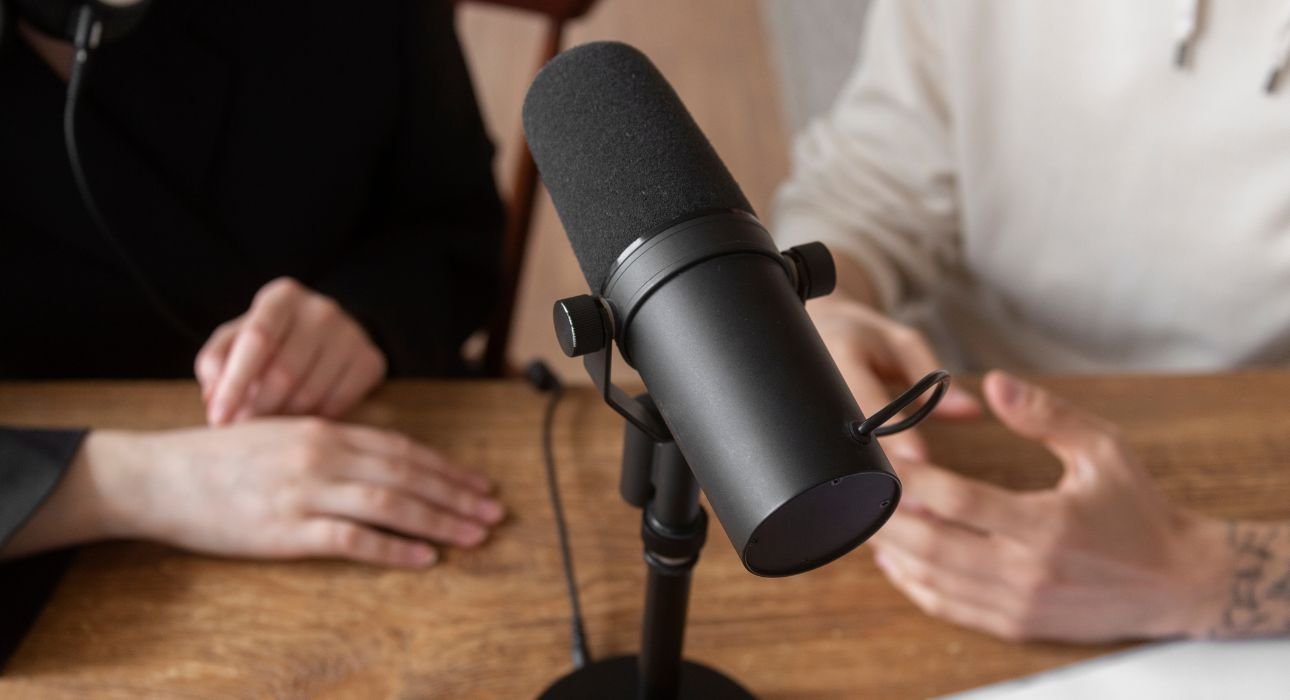The rise of social media has provided everyone with not only the chance to be on screen but also an audience that validates them. But simply carrying a mic doesn’t necessarily show knowledge or credibility.
What initially came out as a force of independent journalism, resistance against the inaccessibility of accurate information to all, and free thinking, over time, it too has become much of what it stood against. While the podcast culture continues to grow and shape public perception each year, the net positive of it remains unclear.
The Rise of the Podcast Era
“A podcast is a piece of episodic, downloadable or streamable, primarily spoken audio content, distributed via the internet, playable anywhere, at any time, produced by anyone who so wishes” (Rime, Pike & Collins, 2022, p.10). Podcasts are easily accessible from any social media site, free of cost. The ease in their accessibility and consumption helps build trust in them. “More than 584 million people listened to podcasts in 2025, with numbers expected to reach 619 million by 2026.”( Riverside, 2025)
1. The Psychology of Persuasion
Why are podcasts popular? Parasocial relationships: This refers to a strong sense of attachment that a person develops for a person they haven’t ever met in real life (Horton & Wohl, 1956). Podcasters are public figures with great influence on the minds of their viewers.
2. Peripheral Route Processing
“the process by which attitudes are formed or changed as a result of using peripheral cues rather than carefully scrutinising and thinking about the central merits of attitude-relevant information.” (APA, 2018) Here, peripheral cues refer to external ideas or readily available information. Rather than employing one’s own cognitive efforts to understand difficult topics, people often find it easier to just listen to the person explaining it on social media.
3. Confirmation Bias
“Confirmation bias, as the term is typically used in the psychological literature, connotes the seeking or interpreting of evidence in ways that are partial to existing beliefs, expectations, or a hypothesis in hand.” (Nickerson, 1998). Listeners often actively choose podcast channels that have views similar to theirs. This leads to a set way of thinking and a deep disinterest in anything that is contradictory to their thinking or beliefs.
Read More: What Confirmation Bias Teaches Us About Human Psychology
4. Emotional Framing
“Research shows that negative news frames often provoke strong emotional reactions, such as fear or anger, which can heavily impact public opinion and behaviour” (Entman, 1993). These podcasts often use emotionally outraging content to impact their listeners deeply.
Social and Environmental Factors Promoting Podcast Culture
1. Distrust in Mainstream Media
“Research shows that as trust in mainstream media networks decreases, audiences increasingly turn to alternative channels such as non-mainstream podcasts, which often spread false claims.” (Andersen et al., 2023). In fact, a 2023 study found that about “49% of US adults listen to podcasts for political information” (Shearer et al., 2023).
2. Need for Social Identity and Community
A large part of a person’s definition of self is derived from their social interactions and group memberships. We explain ourselves in connection to the groups we belong to (Tajfel & Turner, 1979). Through listening to a certain podcaster, a person might find others who share their similar views and at large, they form a collective identity.
Example: COVID era: “In 2021, during the COVID-19 pandemic, Joe Rogan, a popular podcaster with millions of followers, hosted Dr Robert Malone, a well-known conspiracy theorist, on his show. What followed was a discussion of a plethora of misinformation related to the efficacy of COVID lockdowns, vaccines, and treatments” (Caramancion, 2022).
Mechanics of Misinformation
1. Narrative Persuasion
“Narratives can persuade audiences to adopt attitudes in line with story stances” (Hinyard & Kreuter, 2007; Wilkin et al., 2007; Collins et al., 2003; Vaughan & Rogers, 2000; and politics: Slater et al., 2006; Holbert et al., 2003; Holbrook & Hill, 2005; Mutz & Nir, 2010; Wojcieszak & Kim, 2015)
2. Illusion of Authority
This is a tendency of the people to mistake confidence and perceived expertise as actual competence rather than performance. (Olivia & Todorov, 2010). The podcasters explain their ideas in a matter-of-fact tone and with such confidence that the listener is easily convinced of it to be the truth.
3. Algorithms and Visibility
“Online social media platforms significantly influence public debates by shaping the information users encounter” (Conti et al., 2024). While some information is suppressed through a process called shadow banning, some is actually encouraged by the algorithm. Emotionally arousing content is mostly increased as people are likely to interact with it more.
Read More: Misinformation in Your Feed: When Social Media Becomes a Mental Health Risk
The Consequence
- Polarisation: “In recent years, the emergence of ‘grassroots’ media from fringe figures online has led to increased extremism and conspiracy-driven disinformation reaching mainstream audiences” (Samuel, 2025). Misleading narratives often deepen divides and cause immense polarisations.
- Cognitive dissonance: “Cognitive dissonance is described as the mental stress or discomfort experienced by an individual who holds two or more contradictory beliefs, ideas, or values at the same time; performs an action that is contradictory to one or more beliefs, ideas, or values; or is confronted by new information that conflicts with existing ideas, values or beliefs.” (Bohra, Gogoi and Dutta, 2020). When confronted with ideas, beliefs or even solid facts that contradict those of their favourite podcasters, people often double down instead of trying to reconsider.
- Emotional fatigue: The continuous exposure to misinformation, fear mongering or outrage often leads to a feeling of emotional exhaustion and a sense of helplessness.
- Intellectual complacency: This refers to a feeling of satisfaction in having knowledge about something. However, this can be harmful as there is no certainty of knowledge or where it came from.
Combating the Influence
- Critical listening: Viewers should actively engage with what they hear from the podcasters. There should always be an effort to understand and analyse the motivation, intention, “who benefits from this?”, and sources of the information that is provided to them. “It is not just a skill but a fundamental pillar of modern citizenship, enabling people to engage with the world around them more thoughtfully and responsibly” (Curriculum Review, 2017)
- Emotional regulation: “the ability of an individual to modulate an emotion or set of emotions.” (APA, 2018). Viewers should try to identify emotionally triggering messages that are often implied. They should engage in mindful listening and reflect on their thoughts and actions to prevent impulsive actions.
- Platform responsibility: It is a duty of the platforms that showcase these podcasts to ensure that they don’t spread misinformation, hate speech or other violent thoughts and behaviour, instead providing appropriate information suitable for their target audiences.
- Transparency: Podcasters should be transparent about their sources and show proof of their credibility using accurate research, disclaimers and clarifying personal opinions from evidence-based facts.
Read More: Mastering Emotional Regulation: Techniques to Manage Stress and Improve Mental Health
Conclusion
In recent years, with the rise of internet culture, a new form of audio content has become popular. Podcasts initially started as a way to express ideas, independent journalism, and share knowledge. Several studies on podcast culture reveal that through mechanisms such as parasocial relationships, peripheral route processing, confirmation bias and emotional framing, podcasts become popular.
Additionally, a general distrust in traditional and mainstream forms of media, as well as a need for association and social connection, are the environmental factors that promote podcast culture. An example of this is the COVID-era Joe Rogan podcast episode involving a conspiracy theorist. The easy accessibility and formation of podcast channels make them susceptible to misinformation. And this is encouraged through narrative persuasion, illusion of authority, algorithms and visibility.
These podcasts and the misinformation spread by them can have dire consequences on their listeners, involving polarisation, cognitive dissonance, emotional fatigue and intellectual complacency. Through critical listening and media literacy, emotional regulation, encouraging platform responsibility and transparency of sources, this problem of spreading fake information can be combatted.
While podcasts are no doubt a creative form of information sharing, there should always be an attempt to spread true knowledge. It is important to ensure that information is true and intended for the best causes without harming any community, group or other social sphere.
FAQs
1. Why are podcasts popular?
Due to the formation of parasocial relationships, peripheral route processing, confirmation bias and emotional framing, along with a general distrust in mainstream media and a need for social connection, podcasts have become popular.
2. How do podcasts spread misinformation?
Through mechanisms of narrative persuasion, illusion of authority, algorithms and visibility, misinformation is spread by podcasts.
3. How can misinformation be monitored?
Spread of misinformation can be combatted through critical listening and media literacy, emotional regulation, encouraging platform responsibility and transparency of sources.
References +
De Choudhury, M., & Jones, N. (2023). Mental health-related podcasts: Exploring their role in public engagement and awareness. Journal of Mental Health and Media, 5(2), 101–113. https://doi.org/10.1016/j.jomh.2023.101113
Harmon-Jones, E., & Mills, J. (2021). Cognitive dissonance: Its role in decision making. Frontiers in Psychology, 12, 758014. https://doi.org/10.3389/fpsyg.2021.758014
Smith, L., & Zhao, T. (2025). Podcasting the mind: How media formats influence public understanding of psychology. Journal of Broadcasting & Electronic Media, 69(1), 45–62. https://doi.org/10.1080/08838151.2025.2495803
Petty, R. E., & Briñol, P. (2018). Attitude change. In D. Albarracín & B. T. Johnson (Eds.), The handbook of attitudes: Volume 1. Basic principles (2nd ed., pp. 3–43). Psychology Press. https://psycnet.apa.org/record/2018-70006-003
Li, X., & Chen, Y. (2024). GenPod: Constructive news framing in AI-generated podcasts more effectively reduces negative emotions than non-constructive framing. Media Psychology, Advance online publication. https://www.researchgate.net/publication/387382872
Kumar, S., & Banerjee, R. (2024). Revealing the secret power: How algorithms can influence content visibility on social media. Computers in Human Behaviour Reports, 15, 101521. https://www.researchgate.net/publication/385177342













Leave feedback about this